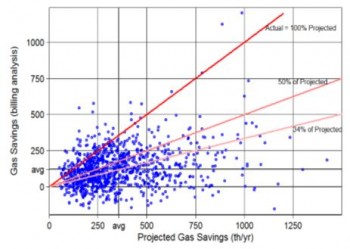Wednesday 25 January 2017
This is a version of the presentation I made at the EASME Energy Efficiency Finance Market Place held in Brussels 18th-19th January 2017.
Good morning, today I am going to talk about three important words for the energy efficiency finance market, standardisation, data and risk.
I am going to start off talking about the so-called low-hanging fruit of energy efficiency, one of the most frequently used and mis-used phrases in energy efficiency. As some of you know I have been spending some time in Saudi Arabia in the last year and there are some very significant things happening in energy efficiency down there. This picture shows some low-hanging dates – by the way if you have not had fresh Saudi Arabian dates you need to try them, they are delicious – but anyway, we need to ban the phrase low-hanging fruit.
This next slide shows that investing in energy efficiency is hard work, really hard work. This is the current situation. It is really hard to deploy capital into energy efficiency, deals take a long-time, deals fall apart after long development periods, and many funds have had trouble deploying capital – sometimes even having to return capital to investors because they cannot find viable deals.
Where we need to get to is summed up in the next slide. We need to move towards large-scale, automated processes for investment – just like we have in other financial markets.
I have talked many times before about the need for standardisation in energy efficiency. EEFIG said it was a major problem, Citi Bank have said it is a major problem, and other players like the IEA have agreed. In fact that need for standardisation was the genesis of the Investor Confidence Project. ICP standardises the development and documentation process for energy efficiency projects in buildings. I found another quote about standardisation that I like: “Standards are like DNA. They are the basic building blocks for all technology and economic standards.” All financial markets are based on standards. The industrial revolution was based on standardisation.
So what do we need to standardise? Firstly the development and documentation process for energy efficiency projects. This is what the Investor Confidence Project does. It now exists. It can be used in all countries in Europe and in the USA. Please use it. It works.
Secondly, we need to standardise the understanding of risks and value. This means counting all the sources of value created by energy efficiency projects and being very clear about all the risks. This is the subject of the Energy Efficiency Financial Institutions Group’s “Value and risk appraisal framework for energy efficiency finance and investments” which we are developing for EEFIG and which will be published in the summer.
Next we need to standardise contracts. A lot of work has been undertaken on this in the context of Energy Performance Contracts (EPCs). There are now several European standard contracts and guides for EPC. Of course, as I have said before, we need to develop other contract models that address the problems that EPCs don’t address. Standard contracts exist and can be used.
Finally we need to standardise performance data and reporting. We are now seeing a number of initiatives to do this including EEFIG’s DEEP. I encourage you to use DEEP and provide additional data for DEEP.
Let’s look at the risks of energy efficiency. When I started in this business many years ago everyone said energy efficiency has no or low risk. Even now people say this. Here is a recent quote I found which will remain anonymous: “The returns are tremendous, and there’s virtually no risk”. This simply is not true. Here is some data from some US projects which show that energy efficiency projects using standard technologies rarely achieve what they are projected to. If you were an investor in these projects, whether you are a householder or a bank, you would not be very happy.
The EEFIG “Value and risk appraisal framework for energy efficiency finance and investments” is a guide to assessing value and risk and aims to provide a common language for project developers and financiers. As well as the document there will be a web based version which will allow anyone to access summary information, more details as well as specific process related resources and references.
Now let’s look at data. Henry Ford launched the first mass-market car the Model T in 1908 and started to change the world. By 1919 car loans were developed and really opened up the market for cars. Therefore we have data on car loan performance for nearly a century. We have data on mortgages for even longer. However, there is still very little data on energy efficiency projects and how they perform. This is due to a number of reasons including:
- Metering and measurement is difficult
- Measurement and Verification relatively new and still not widely used
- Contract forms like EPC mask performance risk
- Performance data considered proprietary.
Data sources are now emerging, or at least the first versions of data sources. The first is DEEP which I mentioned before. There is also Building Button which has been launched by the Investor Confidence Project. The Building Button allows project developers developing projects using the ICP protocols to push a button and start collecting real performance data in a standardised way. There is also The Curve. However, right now even these innovations still have very little real performance data. Collecting and making performance data available is a new concept and of course collecting time series data needs time. An essential part of any future data platform is a common, open source language like BEDES in the USA. Without that we cannot compare like with like, or build data platforms which enable anyone to build apps that mine data for their own specific purposes. The ICP Building Button is based upon BEDES.
So let’s pull together standardisation, data and risk.
First of all different sources of finance take different risks. There is equity which takes equity risks and debt which takes debt risks, and all the shades in-between. PACE financing in the US for example, is based on property tax which is senior to mortgages and is therefore very low risk. People have to pay their PACE repayment on their property taxes or the local government takes over their house. Energy Performance Contracts transfer performance risk to an ESCO but what is the price of transferring that risk? Often too high I think.
We need to move towards a world in which the risks are sliced up and transferred to the parties most willing and able to take those risks. The role of insurance is important here and we are seeing some insurance companies step up to take performance risk, a trend that will expand. Emerging business models like Managed Energy Service Agreements or Metered Energy Efficiency Transactions address risk in different ways. Finally of course, the ultimate source of low-cost capital, the debt capital markets, requires a lot of standardisation and data.
So to sum up, right now we are still in a world in which investing in energy efficiency is a niche activity and is really, really hard work. To move to a world in which it is mainstream and easy we need to make it like every other financial market. To move to that future we need standardisation, acknowledgement and understanding of risks, and data ….. data, data and data.
Thank you.
Thanks to EASME for organising the Energy Efficiency Finance Market Place which was very successful with over 400 attendees which demonstrates the growth of interest in the market.
Comments
There is 1 comment on “Standardisation, data and risk for energy efficiency investments”:
Dr Steven Fawkes
Welcome to my blog on energy efficiency and energy efficiency financing. The first question people ask is why my blog is called 'only eleven percent' - the answer is here. I look forward to engaging with you!
Email notifications
Receive an email every time something new is posted on the blog
Tag cloud
Black & Veatch Building technologies Caludie Haignere China Climate co-benefits David Cameron E.On EDF EDF Pulse awards Emissions Energy Energy Bill Energy Efficiency Energy Efficiency Mission energy security Environment Europe FERC Finance Fusion Government Henri Proglio innovation Innovation Gateway investment in energy Investor Confidence Project Investors Jevons paradox M&V Management net zero new technology NorthWestern Energy Stakeholders Nuclear Prime Minister RBS renewables Research survey Technology uk energy policy US USA Wind farmsMy latest entries
- The RetroMeter project: using metered energy savings to make energy efficiency more investable
- An overview of the ESCO industry
- Applying Energy Efficiency First in financial institutions
- Getting to grips with the complexities of industrial decarbonisation using soft systems
- Back in Brum – home of the Energy Service Company
- Net Zero: A New Front in the Culture Wars?
- Attracting investment to achieve our net zero ambitions







Glad to find that we are thinking in the same direction.
Just last week I spoke about “How proper analysis helps buy, sell, implement and report energy efficiency projects” at the meeting of Association of Energy Engineers Southern Ontario Chapter. One of my points is particularly in line with your blog: When CFOs demand extremely high return from energy projects, they are not evel or mean, they do the best they can with what they have in terms of data, which is very little. It’s engineers’ job is to create such data.